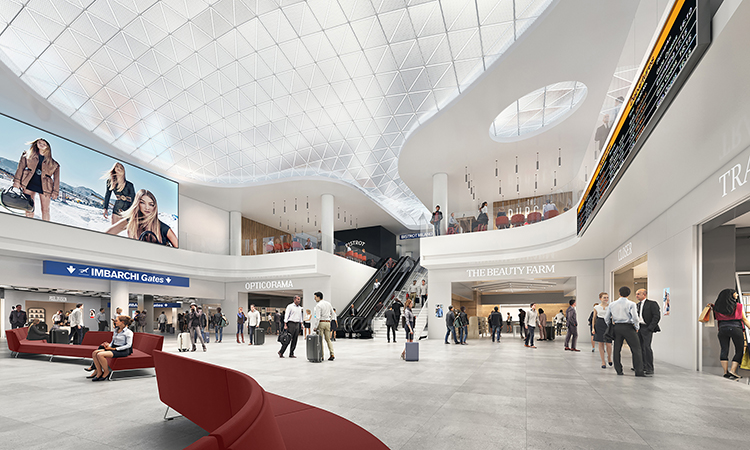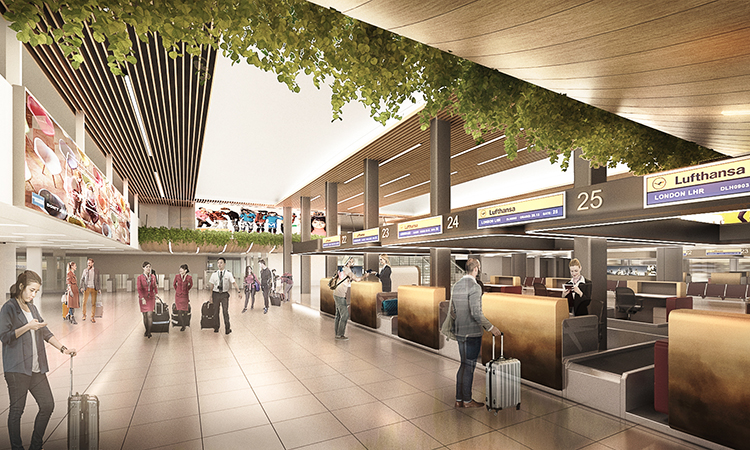Bringing Italian style and design to Milan Linate Airport
- Like
- Digg
- Del
- Tumblr
- VKontakte
- Buffer
- Love This
- Odnoklassniki
- Meneame
- Blogger
- Amazon
- Yahoo Mail
- Gmail
- AOL
- Newsvine
- HackerNews
- Evernote
- MySpace
- Mail.ru
- Viadeo
- Line
- Comments
- Yummly
- SMS
- Viber
- Telegram
- Subscribe
- Skype
- Facebook Messenger
- Kakao
- LiveJournal
- Yammer
- Edgar
- Fintel
- Mix
- Instapaper
- Copy Link
Posted: 21 June 2021 | Alessandro Fidato | No comments yet
Next June, Milan Linate Airport will inaugurate its renovation after undergoing important works to completely restyle the city airport. The terminal – managed along with the intercontinental airport of Milan Malpensa by Società per azioni Esercizi Aeroportuali (SEA) – is now worthy of a city like Milan, explains Alessandro Fidato, Chief Operating Officer of SEA Milan Airports.


Credit: SEA Milan Airports - Corpo F: a new three-storey building with a new shopping gallery and a new food court thanks to a double-height space with an overhanging 'sail'.
The renovation of Milan Linate Airport’s (LIN) terminal started when the airport was closed to air traffic from 27 July to 26 October 2019, allowing for the extraordinary maintenance of flight infrastructures and the functional upgrading to the new European Civil Aviation Conference (ECAC) Standard 3 for the baggage handling system. During this period, air traffic operations for both commercial and general aviation were moved to Milan Malpensa Airport (MXP) thanks to the so-called ‘bridge project’, a hulking relocation process successfully handled by SEA.
At the outbreak of the COVID-19 pandemic, construction works were necessarily halted from 22 March to 4 May 2020. In the same period, health protocols for a safe restart were implemented.
Despite the serious economic impact following the sudden collapse of air traffic, with the consequent need to reassess investment plans, SEA has strongly committed to this project, completing the refurbishment on time.
The revamping of the Linate terminal has involved architectural and functional refurbishment, with a substantial change of the passenger flows and of a considerable part of the existing terminal (also including the check‑in, security and duty free areas) across 5,400m2, together with the construction of a new three-storey building featuring a new shopping gallery and food court at a total investment of €40 million.
The concept
Linate Airport, dating back to 1950, has seen a varying array of architectural choices over the years, leaving it in a state of obsolescence not fitting the importance of the gateway to Milan – the city representing Italian design.
After modernising the building façade in 2018, the ‘Architectural Restyling and Ambience’ project began, aiming to completely refurbish the terminal interior in order to improve customer satisfaction. The project fused architectural harmonisation and interior design, implementing a ‘green’ vision, with a particular eye on comfort and finish quality. Furthermore, a smooth passenger experience is ensured through the implementation of innovative technologies and the use of automation (smart security, biometrics, common self-bag drop, etc).
To carry out the work and minimise the impact on airport operations, a temporary terminal was built in prefabricated elements on the aircraft apron close to the terminal to replace the gates that were being renovated.
The renovation of Milan Linate Airport’s (LIN) terminal started when the airport was closed to air traffic from 27 July to 26 October 2019, allowing for the extraordinary maintenance of flight infrastructures and the functional upgrading to the new European Civil Aviation Conference (ECAC) Standard 3 for the baggage handling system. During this period, air traffic operations for both commercial and general aviation were moved to Milan Malpensa Airport (MXP) thanks to the so-called ‘bridge project’, a hulking relocation process successfully handled by SEA.
At the outbreak of the COVID-19 pandemic, construction works were necessarily halted from 22 March to 4 May 2020. In the same period, health protocols for a safe restart were implemented.
Despite the serious economic impact following the sudden collapse of air traffic, with the consequent need to reassess investment plans, SEA has strongly committed to this project, completing the refurbishment on time.
The revamping of the Linate terminal has involved architectural and functional refurbishment, with a substantial change of the passenger flows and of a considerable part of the existing terminal (also including the check‑in, security and duty free areas) across 5,400m2, together with the construction of a new three-storey building featuring a new shopping gallery and food court at a total investment of €40 million.
The concept
Linate Airport, dating back to 1950, has seen a varying array of architectural choices over the years, leaving it in a state of obsolescence not fitting the importance of the gateway to Milan – the city representing Italian design.
After modernising the building façade in 2018, the ‘Architectural Restyling and Ambience’ project began, aiming to completely refurbish the terminal interior in order to improve customer satisfaction. The project fused architectural harmonisation and interior design, implementing a ‘green’ vision, with a particular eye on comfort and finish quality. Furthermore, a smooth passenger experience is ensured through the implementation of innovative technologies and the use of automation (smart security, biometrics, common self-bag drop, etc).
To carry out the work and minimise the impact on airport operations, a temporary terminal was built in prefabricated elements on the aircraft apron close to the terminal to replace the gates that were being renovated.
Ambience
The first impact is clear upon entering the departure area: the check-in area has been re-styled, proposing a new identity that characterises the spaces, atmosphere and the materials of the new terminal. The terminal’s ‘new image’ has been designed with great consideration, incorporating both the principles of formal and material quality and environmental sustainability. The perceptions and movements of both passengers and airport operators have been analysed according to the most innovative neuroscience methodologies in order to create the proper visual and acoustic comfort.
A new vertical pathway (escalators, stairs and a high-capacity lift) has been built for passengers coming from the new Linate M4 underground station (now being commissioned following the conclusion of the construction phase) to the check-in area.
Features
Green canopies and dropped ceilings
The project includes the refurbishment of the double-height space with a system of roof gardens, with plants and shrubs overlooking the first floor, creating a green, spacious atmosphere. The dropped ceilings have been upgraded, substituting the existing ones with wooden-like slats alternating with plasterboard sails, drawing attention to the surrounding space and giving uniformity and cleanliness to the design. An integrated lighting system will emphasise the curved lines of the sails and the LED profiles alternating with the slats.
Check‐in desks
The desks have been re-styled according to the SEA brand, with a design characterised by soft edges and functionally, bridging the relationship between operator and customer thanks to the front support shelf with brass coating, treated with acid‑etching processes. An accent lighting system with an overlooking band, in line with the design of the counters, completes the ambience.


Credit: SEA Milan Airports – Rendering of the check-in area.
A new security area
In October 2020, the new security area was inaugurated. It was designed for passengers’ needs thanks to technologies and architectural elements that grant a highly innovative travel experience, once again applying neuroscience to architectural design. In fact, particular attention was given to the colours and materials used for the walls, floors and dropped ceilings. Lights and spaces have been optimised to reduce passenger anxiety, which is usually elevated when passing through security checks.
Lights and spaces have been optimised to reduce passenger anxiety, which is usually elevated when passing through security checks”
The innovation of the security system is evident when checking in. Through the ‘face boarding’ system, the passenger will be able to comfortably link their ID card or passport and boarding pass to their biometric data. On their way to the gate, starting from the airport entrance right up to boarding the aircraft, the passenger will find special dedicated contact points without the need to show any documents, thus reducing personal contact and speeding up their transit through the checkpoints.
At security checks, the passenger is welcomed by a security operator who will direct them to the new automated line, where traditional X-ray machines have been replaced by EDS-CB (explosives detection systems for cabin baggage) appliances with computed axial tomography technology. The high security level of the system allows controls to be carried out without the need to take electronic devices and liquids out of bags, ensuring an enhanced travel experience.
Corpo F
The works for functional reconfiguration and architectural renovation have involved the one‑storey part of the terminal known as ‘Corpo F’ (Block F). It has been completely demolished in order to build a new three-storey building with a total surface of approximately 10,000m2, with a significant change in passenger flows, the widening of boarding areas, a new shopping gallery and a new food court thanks to a double-height space with an overhanging ‘sail’. Corpo F has been BREEAM-in-use certified as ‘excellent’.
To amplify the sense of place in tune with Milan, the avant-garde and as a symbol of Italian design to the world, historical works by renowned Italian designers have been placed along the passenger journey thanks to an important partnership with the Milan Triennale Design Museum. This enriches the cultural value of the terminal and gives it a sense of identity.
From the security area via the walk-through duty‑free, passengers reach a wide central double‑height plaza and a shopping gallery characterised by a curvilinear development. Twenty‑three (versus the existing 13) shops are expected, newly renovated and featuring Italian luxury brands such as Dolce & Gabbana, Emporio Armani, Ermenegildo Zegna and so on.
From the central plaza, a double vertical path takes passengers to the food court on the second floor and, after the shopping gallery, leads to the ground floor to the bus boarding gates and boarding bridge gates.
Most parts of the second floor will be dedicated to the food court (managed by HMS Host), looking down onto the plaza below and the apron; a wide VIP lounge will be created, together with a workstation area, a smoking area and two new restrooms for passengers.
On the ground floor, more space has been given to remote gates A1 to A8 and their pre‑boarding areas, with new ramps onto the apron. Behind them are shops and a food area. The restrooms have been completely re-styled and re-built to include a nursery, a breastfeeding area and baby changing facilities.
“Thank you”
The author would like to thank SEA’s Infrastructure Development, Non‑Aviation Business, Supply Chain and ICT teams and all of the designers who have succeeded in interpreting the new identity of the terminal, including SAB – Architettura Ingegneria Integrata and Gnosis Progetti, as well as the architects A. De Martino, G. Caccia Dominioni, C. Ferrara, D. Ruzzon.
Alessandro Fidato is an Italian Civil Engineer and an Airport Planning and Management Masters graduate. He has more than 25 years’ experience in the transport industry. He started his career in high-speed railway construction and then moved to Rome Fiumicino Airport (ADR), where he was responsible for several projects related to the last large expansion on both Fiumicino and Ciampino Airports regarding both airside and landside infrastructures.
In 2010, Fidato joined Naples International Airport (2i Aeroporti) as Technical Director, becoming Operations Director and Accountable Manager from 2014 and Chief Operating Officer from January 2018. Since March 2019, Fidato has been acting as the Chief Operating Officer and Accountable Manager for SEA Milan Airports (Municipality of Milan and 2i Aeroporti).
Issue
Related topics
Airport construction and design, Airside operations, Baggage handling, Biometrics, COVID-19, New technologies, Passenger experience and seamless travel, Retail, Security, Sustainable development, Terminal operations
Related airports
Related organisations
European Civil Aviation Conference (ECAC), SEA – Milan Airports


















